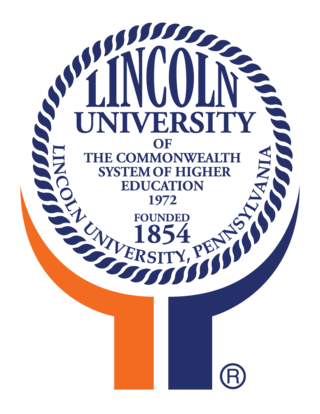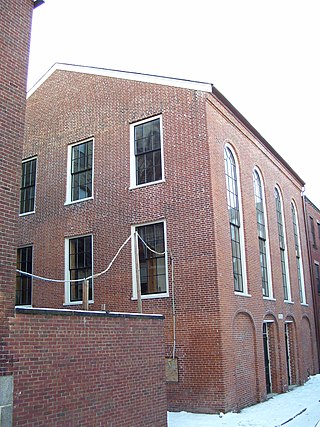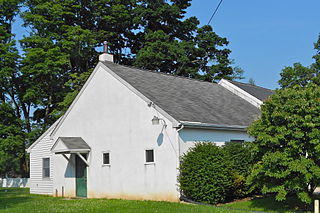The African Union First Colored Methodist Protestant Church and Connection, usually called "the A.U.M.P. Church," is a Methodist denomination. It was chartered by Peter Spencer (1782–1843) in Wilmington, Delaware, in 1813 as the "Union Church of Africans," where it became known as the "African Union Church".

William Still was an African-American abolitionist based in Philadelphia, Pennsylvania. He was a conductor on the Underground Railroad and was responsible for helping 650 freedom seekers make their way to Canada. Still was also a businessman, writer, historian and civil rights activist. Before the American Civil War, Still was chairman of the Vigilance Committee of the Pennsylvania Anti-Slavery Society, named the Vigilant Association of Philadelphia. He directly aided fugitive slaves and also kept records of the people served in order to help families reunite.

Lincoln University (LU) is a public state-related historically black university (HBCU) near Oxford, Pennsylvania. Founded as the private Ashmun Institute in 1854, it has been a public institution since 1972 and is the second oldest HBCU in the state after Cheyney University of Pennsylvania. Its main campus is located on 422 acres near the town of Oxford in southern Chester County, Pennsylvania. The university has a second location in the University City area of Philadelphia. Lincoln University provides undergraduate and graduate coursework to approximately 2,000 students. It is a member-school of the Thurgood Marshall College Fund.

Thomas Garrett was an American abolitionist and leader in the Underground Railroad movement before the American Civil War. He helped more than 2,500 African Americans escape slavery.

The Boston African American National Historic Site, in the heart of Boston, Massachusetts's Beacon Hill neighborhood, interprets 15 pre-Civil War structures relating to the history of Boston's 19th-century African-American community, connected by the Black Heritage Trail. These include the 1806 African Meeting House, the oldest standing black church in the United States.
Erastus Hussey (1800–1889) was a leading abolitionist, a stationmaster on the Underground Railroad, and one of the founders of the Republican Party. He supported himself and his family as a farmer, teacher, businessman, legislator, and editor.

Samuel D. Burris was a member of the Underground Railroad. He had a family, who he moved to Philadelphia for safety and traveled into Maryland and Delaware to guide freedom seekers north along the Underground Railroad to Pennsylvania.

The F. Julius LeMoyne House is a historic house museum at 49 East Maiden Street in Washington, Pennsylvania. Built in 1812, it was the home of Dr. Francis Julius LeMoyne (1798–1897), an antislavery activist who used it as a stop on the Underground Railroad. LeMoyne also assisted in the education of freed slaves after the American Civil War, founding the historically black LeMoyne–Owen College in Memphis, Tennessee. His house, now operated as a museum by the local historical society, was designated a National Historic Landmark in 1997. It is designated as a historic public landmark by the Washington County History & Landmarks Foundation.

Ercildoun, population about 100, is an unincorporated community in East Fallowfield Township, Chester County, Pennsylvania, United States. The hamlet was founded by Quakers and was an early center of the abolitionist movement. In 1985 the entire hamlet, including 31 properties, was listed as a historic district on the National Register of Historic Places. Of these properties two were vacant land, 14 were significant buildings, ten were contributing buildings, and five buildings, built in the 1950s, were non-contributing. The Lukens Pierce House, an octagon house listed separately on the U.S. National Register of Historic Places, is located about half a mile northwest of the hamlet. Ercildoun is one of about ten hamlets in the township, which has no cities or towns, but has 31 sites listed on the National Register. It is one of the larger hamlets, located near the center of the township, and historically among the best known. The city of Coatesville is about 3 miles north.

Bethel A.M.E. Church, now known as the Central Pennsylvania African American Museum, is a historic African Methodist Episcopal church at 119 North 10th Street in Reading, Berks County, Pennsylvania. It was originally built in 1837, and is a 2½-storey brick and stucco building with a gable roof. It was rebuilt about 1867–1869, and remodeled in 1889. It features a three-storey brick tower with a pyramidal roof topped by a finial. The church is known to have housed fugitive slaves and the congregation was active in the Underground Railroad. The church is now home to a museum dedicated to the history of African Americans in Central Pennsylvania.

Bethel African Methodist Episcopal Church is a historic African Methodist Episcopal Church in Springtown, New Jersey, United States. The church was part of two free negro communities, Othello and Springtown, established by local Quaker families. The congregation was established in 1810 in Greenwich Township as the African Methodist Society and joined the African Methodist Episcopal Church in 1817. A previous church building was burned down in the 1830s in an arson incident and the current structure was built between 1838 and 1841.

Hovenden House, Barn and Abolition Hall is a group of historic buildings in Plymouth Meeting, Whitemarsh Township, Montgomery County, Pennsylvania. In the decades prior to the American Civil War, the property served as an important station on the Underground Railroad. Abolition Hall was built to be a meeting place for abolitionists, and later was the studio of artist Thomas Hovenden.

Amy Hester "Hetty" Reckless was a runaway slave who became part of the American abolitionist movement. She campaigned against slavery and was part of the Underground Railroad, operating a Philadelphia safe house. She fought against prostitution and vice, working toward improving education and skills for the black community. Through efforts including operating a women's shelter, supporting Sunday Schools and attending conferences, she became a leader in the abolitionist community. After her former master's death, she returned to New Jersey and continued working to assist escaping slaves throughout the Civil War.
Hinsonville is a former municipality in Chester County, Pennsylvania which is now largely replaced by the grounds of Lincoln University. It was established and mostly populated by free African American residents, with the acres of Hinsonville being first purchased by Edward Walls, a free black man who was born in Maryland, in 1829. The town was named for its first permanent resident, Emory Hinson, another Maryland-born free black man. Located six miles north of the Mason–Dixon line and at the crossroads of Russellville-Elkdale Road and Oxford-Jennersville Road in the southern tip of Upper Oxford Township, the agricultural community of Hinsonville became an ideal residence for African Americans escaping slavery in neighboring Maryland from the 1820s to the 1850s. By 1843–1845, when the Hosanna Meeting House was established in town, Hinsonville had expanded considerably due to the flight of free black families from the South.
Lincoln Cemetery was founded in November 1877 by the Wesley Union African Methodist Episcopal Zion Church, and is located at 201 South 30th Street in the Penbrook area of Harrisburg, Pennsylvania.
Indian Run is a populated place in Wilmington Township of Mercer County, Pennsylvania, named for the stream Indian Run. Indian Run had a reputation as a "safe haven" for African Americans, whether they were free or escaping slavery. White Chapel Church was established by abolitionists who broke away from a church in New Wilmington. In the 1840s, a settlement was created for freedmen called Pandenarium. John Young and others were prominent Underground Railroad conductors.
Isaac S. Flint was an Underground Railroad station master, lecturer, farmer, and a teacher. He saved Samuel D. Burris, a conductor on the Underground Railroad, from being sold into slavery after having been caught helping runaway enslaved people.

Eusebius Barnard was an American farmer and station master on the Underground Railroad in Chester County, Pennsylvania, helping hundreds of fugitive slaves escape to freedom. A minister of the Progressive Friends and founding member of Longwood Meeting House, Barnard championed women’s rights, temperance, and abolition of slavery. A Pennsylvania state historical marker was placed outside his home in Pocopson Township on April 30, 2011.

Isaac Mendenhall was an American farmer, abolitionist, and station master on the Underground Railroad in Chester County, Pennsylvania. Isaac and Dinah Mendenhall aided several hundred fugitives to escape to freedom. Prosperous farmers, they lived at the estate of Oakdale, listed on the National Register of Historic Places since 1972. A Pennsylvania state historical marker was dedicated in their honor on November 10, 2018.













